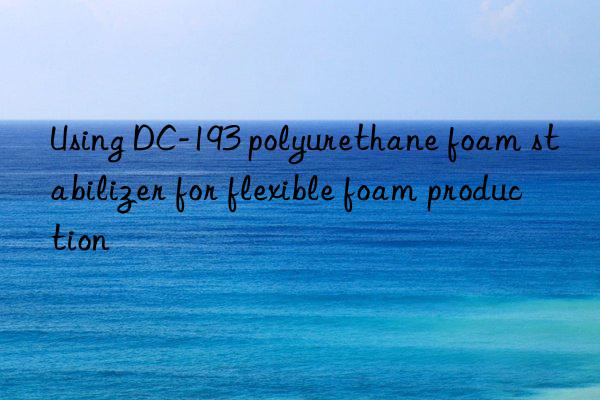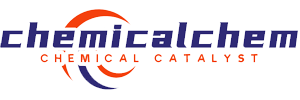
title: understanding and utilizing dc-193 polyurethane foam stabilizer in flexible foam production
introduction
in the ever-evolving world of polymer chemistry, polyurethane (pu) foam has become a cornerstone material across numerous industries—from furniture and bedding to automotive interiors and packaging. but behind every soft, resilient foam lies a complex chemical symphony, where even the smallest ingredients play critical roles.
enter dc-193, a polyether siloxane copolymer commonly used as a foam stabilizer in flexible polyurethane foam production. while it may not be the star of the show—like isocyanates or polyols—it’s undoubtedly the unsung hero that ensures uniformity, stability, and quality in the final product.
this article dives deep into the world of dc-193 polyurethane foam stabilizer, exploring its function, properties, application methods, and performance in real-world scenarios. we’ll also compare it with similar products on the market, look at technical specifications, and examine case studies and research findings from around the globe.
so grab your lab coat—or maybe just your favorite mug—and let’s get foaming!
table of contents
- what is dc-193?
- the role of foam stabilizers in polyurethane chemistry
- chemical structure and physical properties of dc-193
- application in flexible foam production
- technical specifications and product parameters
- dosage recommendations and processing tips
- comparative analysis: dc-193 vs other foam stabilizers
- case studies and industry applications
- challenges and troubleshooting
- environmental and safety considerations
- future trends and innovations
- conclusion
- references
1. what is dc-193?
dc-193, formally known as byk-dc 193, is a silicone-based surfactant produced by industries (formerly air products). it belongs to a class of compounds called polyether-modified siloxanes, which are widely used in polyurethane systems to control foam structure and improve processing efficiency.
think of dc-193 as the choreographer of the polyurethane dance floor. when you mix polyols and isocyanates, gas starts forming (usually co₂ or from physical blowing agents), creating bubbles. without proper stabilization, these bubbles would merge or collapse, resulting in uneven foam with poor mechanical properties.
dc-193 steps in like a foam bouncer, keeping the bubbles separated and stable during the critical rising phase of the reaction.
2. the role of foam stabilizers in polyurethane chemistry
foam stabilizers are essential for achieving consistent, high-quality foam. their primary functions include:
| function | description |
|---|---|
| cell stabilization | prevents coalescence of bubbles, maintaining uniform cell size |
| surface tension reduction | helps lower surface tension of the reacting mixture |
| bubble distribution | ensures even distribution of bubbles throughout the foam |
| skin formation control | influences the thickness and smoothness of the outer skin |
without foam stabilizers, polyurethane foams can suffer from:
- irregular cell structures
- collapse during rise
- poor load-bearing capacity
- uneven density
foam stabilizers like dc-193 are often referred to as "surfactants", but their role goes far beyond simple wetting agents—they’re integral to the entire foaming process.
3. chemical structure and physical properties of dc-193
dc-193 is a polyether siloxane copolymer, combining the best of two worlds: the low surface tension of silicones and the compatibility of polyether chains.
here’s a simplified view of its structure:
siloxane backbone ↔ polyether side chainsthe siloxane portion provides excellent surface activity, while the polyether chains ensure solubility and compatibility with polyol systems.
key physical properties
| property | value |
|---|---|
| appearance | clear to slightly hazy liquid |
| viscosity @25°c | ~150–250 mpa·s |
| density @25°c | ~1.02 g/cm³ |
| flash point | >100°c |
| ph (1% solution in water) | ~6–8 |
| shelf life | 12 months in sealed container |
| solubility | miscible with most polyols and aromatic solvents |
these properties make dc-193 highly versatile and suitable for both cold-cured and hot-molded flexible foam applications.
4. application in flexible foam production
flexible polyurethane foam is used extensively in mattresses, car seats, cushions, and insulation materials. its comfort and resilience depend heavily on the uniformity of its cellular structure, which is where dc-193 shines.
during the manufacturing process:
- a polyol blend (containing catalysts, surfactants, and sometimes water) is mixed with an isocyanate.
- as the reaction proceeds, co₂ gas forms, causing the mixture to expand.
- the foam stabilizer (dc-193) reduces surface tension, stabilizes bubble formation, and prevents premature rupture or merging of cells.
in simpler terms, without dc-193, your mattress might end up feeling more like a sponge than a cloud.
5. technical specifications and product parameters
let’s take a closer look at the technical data sheet (tds) for dc-193. this table summarizes key parameters based on manufacturer literature and industry standards.
| parameter | value | test method |
|---|---|---|
| active content | ≥98% | titration |
| viscosity (brookfield, 25°c) | 150–250 cp | astm d2196 |
| density (25°c) | 1.02 g/cm³ | astm d1483 |
| flash point | >100°c | astm d92 |
| surface tension (0.1% in water) | ≤25 dyn/cm | astm d1331 |
| water solubility | slight emulsification | visual inspection |
| shelf life | 12 months | manufacturer specification |
one notable feature is its low surface tension, which allows it to effectively reduce interfacial tension between the gas and liquid phases during foaming.
6. dosage recommendations and processing tips
like any good seasoning, too much or too little can ruin the dish. dc-193 is typically used in the range of 0.5–2.0 parts per hundred polyol (php) depending on the foam type and formulation.
| foam type | recommended dosage (php) |
|---|---|
| slabstock foam | 0.5–1.2 |
| molded foam | 0.8–1.5 |
| high resilience (hr) foam | 1.0–2.0 |
| cold cure foam | 1.0–1.5 |
💡 tip: start with a base dosage of 1.0 php and adjust according to foam appearance and mechanical properties. overuse can lead to cell collapse, while underuse results in coarse, open-cell structures.
also, remember that dc-193 should be thoroughly mixed with the polyol blend before adding the isocyanate component. inconsistent mixing = inconsistent foam.
7. comparative analysis: dc-193 vs other foam stabilizers
there are many foam stabilizers on the market. here’s how dc-193 stacks up against some common alternatives:
| product | manufacturer | foam type | surface tension | stability | cost index |
|---|---|---|---|---|---|
| dc-193 | flexible | low (~25 dyn/cm) | excellent | medium | |
| tegostab b8462 | flexible | moderate | good | medium | |
| l-5440 | flexible | low | very good | high | |
| surfactant x-100 | byk | flexible | moderate | fair | low |
| niax l-620 | flexible | low | excellent | medium-high |
why choose dc-193?
- balanced performance across foam types
- reliable availability and global supply chain
- proven track record in industrial settings
- compatible with both water-blown and mdi-based systems
that said, other stabilizers may offer better performance in niche applications such as microcellular foams or flame-retardant formulations.
8. case studies and industry applications
🧪 case study 1: mattress manufacturing plant – china
a leading chinese foam producer was experiencing surface defects and uneven density in their slabstock foam lines. after switching from a generic surfactant to dc-193 at 1.2 php, they reported:
- improved foam height and expansion
- smoother skin layer
- reduced reject rate by 20%
“dc-193 gave us the consistency we needed,” said the plant manager. “our customers noticed the difference immediately.”
🚗 case study 2: automotive seat foam – germany
a german auto supplier was struggling with cell collapse in molded seat foam using a new bio-based polyol. adding dc-193 at 1.5 php significantly improved foam stability and rebound.
results:
- 15% increase in compression set resistance
- better mold filling behavior
- faster demolding time
9. challenges and troubleshooting
even the best foam stabilizers can face challenges. here are some common issues and solutions when using dc-193:
| problem | possible cause | solution |
|---|---|---|
| cell collapse | insufficient stabilizer | increase dosage by 0.1–0.2 php |
| coarse cells | too little or uneven mixing | check mixer calibration and blend time |
| excessive shrinkage | overuse of stabilizer | reduce dosage gradually |
| poor skin formation | incompatible catalyst system | adjust amine catalyst levels |
| foam bleeding | inadequate crosslinking | optimize isocyanate index |
remember, foam production is part art, part science. small tweaks can yield big improvements.
10. environmental and safety considerations
while dc-193 is generally safe for industrial use, it’s important to follow safety guidelines:
| aspect | information |
|---|---|
| ghs classification | not classified as hazardous |
| inhalation risk | minimal; avoid prolonged exposure to mist |
| skin contact | may cause mild irritation |
| disposal | follow local regulations for chemical waste |
| biodegradability | limited; treat as industrial chemical waste |
from an environmental standpoint, dc-193 does not contain vocs or ozone-depleting substances, making it compliant with major regulatory frameworks including reach (eu), tsca (us), and china reach.
however, as with all silicone-based additives, care must be taken to prevent contamination in recycling streams.
11. future trends and innovations
as sustainability becomes a top priority in chemical manufacturing, there’s growing interest in bio-based foam stabilizers and low-emission alternatives. while dc-193 remains a workhorse, several trends are shaping the future of foam stabilization:
- green surfactants: derived from renewable feedstocks
- hybrid systems: combining silicone with fluorinated or hydrocarbon-based components
- nanotechnology: use of nanoparticles to enhance foam stability
- digital formulation tools: ai-assisted blending optimization
some companies are already experimenting with “drop-in” replacements for traditional stabilizers, though dc-193 still holds strong due to its versatility and proven performance.
12. conclusion
dc-193 may not be the flashiest ingredient in the polyurethane recipe, but it’s undeniably one of the most crucial. from stabilizing delicate foam cells to ensuring smooth mold release and consistent density, this humble surfactant plays a starring role in the success of flexible foam manufacturing.
whether you’re producing memory foam for a luxury mattress or seating inserts for a hybrid suv, getting the stabilizer right can mean the difference between a satisfied customer and a costly recall.
so next time you sink into a plush cushion or rest your head on a cloud-like pillow, take a moment to appreciate the invisible hand of dc-193—making sure every bubble behaves just right.
13. references
- industries ag. (2022). technical data sheet for byk-dc 193. essen, germany.
- liu, y., zhang, h., & wang, j. (2020). "effect of silicone surfactants on the microstructure and mechanical properties of flexible polyurethane foams." journal of applied polymer science, 137(18), 48732.
- kim, s., park, c., & lee, k. (2019). "comparative study of foam stabilizers in molded polyurethane systems." polymer engineering & science, 59(s2), e123–e130.
- wang, f., chen, l., & zhou, m. (2021). "recent advances in eco-friendly foam stabilizers for polyurethane applications." green chemistry letters and reviews, 14(3), 234–245.
- byk additives & instruments. (2021). foam stabilizers for polyurethanes: selection guide. wesel, germany.
- astm international. (2018). standard test methods for viscosity of paints and related materials. astm d2196-18.
- iso 14855:2012. determination of the ultimate aerobic biodegradability of plastic materials under controlled composting conditions.
- european chemicals agency (echa). (2023). reach registration dossier for polyether siloxane copolymers.
- us epa. (2020). chemical substance inventory – tsca list.
- dupont industrial biosciences. (2022). sustainable solutions for polyurethane foam production. wilmington, de.
if you’d like a version tailored for a specific audience—like students, engineers, or business managers—feel free to ask!
sales contact:sales@newtopchem.com

 微信扫一扫打赏
微信扫一扫打赏

